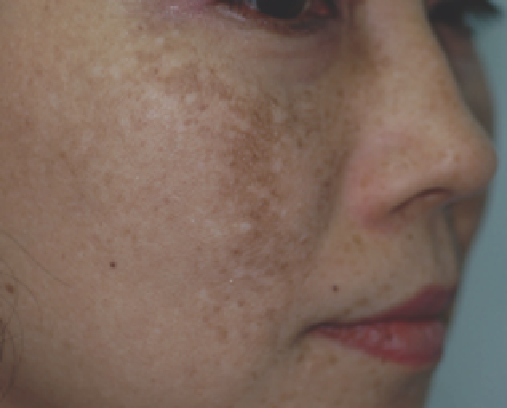Biomedical Engineering Reference
In-Depth Information
A variable square pulse (VSP) erbium:yttrium-aluminum-
garnet (Er:YAG) laser is an alternative of a minimally ablative
laser resurfacing technique that has proved to be effective and
safe for treatment of epidermal-type melasma (99). Signifi cant
improvement in visual analog scale (VAS) and MASI score
from baseline were noted at 2 months following two treatment
sessions (Fig. 13.13). Mild PIH developed in 18% of the
patients and cleared spontaneously within 2 weeks. VSP
Er:YAG pulses provide more-controlled heating of tissue and
minimal epidermal vaporization. This minimally ablative laser
resurfacing results in greater epidermal turnover and “washing
out” of pigment. This results in a decrease in lesional hyper-
pigmentation but not elimination of the problem. When com-
bined with a topical regimen of hydroquinone, retinoids,
vitamin C, and sunscreens, a successful maintenance program
can be crafted for melasma.
Nonablative fractional photothermolysis (FP) laser has
increasingly been performed for treatment of recalcitrant
melasma (49,100-103). The mechanism by which pigmented
component is eliminated probably involves the extrusion and
transepidermal vacuolar elimination of dermal and epidermal
melanin content through a compromised dermoepidermal
junction. This transport system is activated by FP whereby
microscopic epidermal necrotic debris is shuttled through the
epidermis to be eliminated by epidermal vacuoles (104). Pilot
studies showed the effectiveness of FP in melasma, but most of
them had a small sample size and/or a short follow-up period
(102,105).
Lee et al. (101) treated Korean patients with melasma with
four monthly FP sessions and followed up to 24 weeks after
treatment completion. Clinical improvements of 60% were
observed in 44% of the patients at 4 weeks after treatment, but
the improvements decreased to 52% in 35% of the subjects at
24 weeks after treatment. Our experience in treating melasma
with FP was similar to that of aforementioned study. We noted
that FP led to some clinical improvements, but melasma
tended to recur as early as 3 months after treatment was
discontinued.
Wind and colleagues (106) compared effi cacy and safety of
nonablative 1550-nm fractional laser therapy (FLT) and triple
topical therapy (TTT; hydroquinone 5%, tretinoin 0.05%,
triamcinolone acetonide 0.1% cream) in 29 Chinese with
melasma. Mean patient's global assessment and satisfaction
were signifi cantly lower at the FLT side. Physician's global
assessment and melanin index showed a signifi cant worsen-
ing of hyperpigmentation at the FLT side. At 6 months follow-
up, most patients preferred TTT. Adverse effects of FLT were
erythema, burning sensation, edema, and pain. Moreover,
PIH developed in 31% of the patients after two or more laser
sessions. Similarly, results from a recent prospective con-
trolled single-blinded trial in 51 patients showed that four FP
treatments at 3-week intervals did not provide a specifi c effect
on melasma that is superior to an application of sunscreens
alone (107).
A round table discussion among experienced physicians and
a review of up-to-date literature fi ndings also did not have
complete consensus for the use of an erbium-doped 1550-nm
fractionated laser for the treatment of melasma (103). There-
fore, physicians should proceed with caution when treating
melasma, especially in patients with dark-skin phototypes.
Figure 13.11
Confetti-like hypopigmented and recurrence of melasma at
6 months after low-fl uence Q-switched 1064-nm neodymium-doped:yttrium-
aluminum-garnet laser toning in Thai woman with skin phototype IV.
Confetti-like or spotty hypopigmented macules or punctate
leukoderma is a common side effect associated with low-
fl uence QS 1064-nm Nd:YAG laser for skin rejuvenation and
melasma (Fig. 13.11) (91,92). Chan et al. (91) assessed a case
series of 14 Chinese patients with laser toning-associated facial
depigmentation with cross-polarized and UV photographic
images. Of all 14 patients, 9 received laser toning for nonabla-
tive skin rejuvenation and the other 5 for melasma. Treatment
protocols received by these patients were highly variable. The
total number of treatments received ranged from 6 to 50
(mean 22). In all cases, UV photographic images demonstrated
facial mottled depigmentation. Laser toning failed to signifi -
cantly improve melasma in all fi ve patients.
The use of resurfacing lasers alone (93,94) or combined with
a pigment-specifi c laser (95,96) have shown favorable results in
the treatment of melasma. However, PIH commonly develops
and can last for 3-6 months. This temporary worsening of the
pigmentation may result from an infl ammatory dermal reac-
tion that stimulates the activity of melanocytes in the melasma-
irradiated skin. Our own experience has found that PIH occurs
in nearly 100% of the patients with skin types III and IV who
underwent CO
2
laser resurfacing for treatment of melasma.
Segmental hypopigmentation or pseudohypopigmentation is
another common complication that develops when only the
melasma area is resurfaced (Fig. 13.12). Pseudohypopigmenta-
tion, the situation in which the resurfaced area has a relatively
light skin color, is similar in color to the pigmentation of non-
sun-exposed skin but contrasts distinctively with the more
darkly pigmented photodamaged adjacent skin.
The etiology of melasma remains unknown. The idea behind
such an aggressive approach is that melasma may be caused by
an abnormal epidermis, not abnormal melanocytes. This idea
is supported by fi ndings from previous studies showing that
keratinocytes play a role in regulating distribution patterns of
recipient melanosomes (97,98). Considering the expense and
the risk of adverse effects, the use of laser resurfacing alone or
combined techniques should be preserved for those refractory
melasma that do not respond to conventional treatments.

















